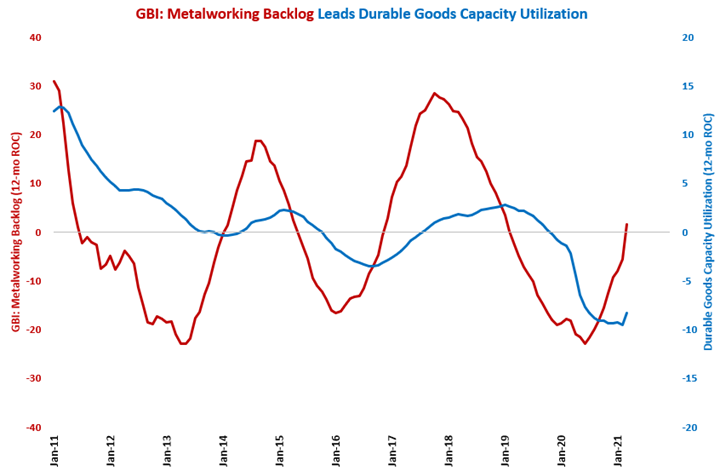Capacity Utilization Growth Fastest Since March 2011
Compared with one year ago, capacity utilization grew at its fastest rate in March 2021 since March 2011. This was partly due to an easy comparison with March 2020, comparisons that will get even easier in April and May. The fast growth in capacity utilization was also due to strong manufacturing activity as the Gardner Business Index showed.
In March, durable goods capacity utilization was 73.5%, which was the second-highest rate of capacity utilization since February 2020. Compared with one year ago, capacity utilization increased 6.4%, which was the first month of growth in capacity utilization since May 2019 and the fastest rate of growth since March 2011. Of course, comparison with March 2020 was relatively easy and April and May will be even easier.
The annual change in durable goods capacity utilization contracted at a decelerating rate for the first time this cycle. The annual rate of contraction of 8.3% was the slowest since June 2020. It seems clear that the annual rate of change is bottoming out. As the annual rate of change tends to lead capital equipment consumption by seven to 10 months, capacity utilization is signaling a bottom in the annual rate of change in capital equipment about the second quarter of 2021.
The GBI: Metalworking backlog index tends to lead the annual rate of change in capacity utilization by seven to 10 months. In March, the backlog index was 62.5, its highest level ever, and above 50, indicating growth in backlogs, for the fourth straight month. The backlog index grew 73.6% compared with one year ago. This was the seventh straight month of growth. The annual rate of contraction in the backlog index reached a bottom in June and has contracted at a decelerating rate for nine months, indicating that the annual rate of change in capacity utilization should see decelerating contraction for most of 2021.

Every industry that we track, except two, shifted to decelerating contraction from accelerating contraction in March. This means that the one-month and three-month rates of change are now growing and will start to lift the annual rate of change.
Accelerating Growth:
Decelerating Growth:
Accelerating Contraction: electronics/computers, wood/paper products
Decelerating Contraction: aerospace, automotive, construction materials, custom processors, durable goods, food/beverage processing, forming/fabricating (non-auto), furniture, machinery/equipment, plastics/rubber products, petrochemical processors, primary metals, printing, textiles/clothing/leather goods




.JPG;width=70;height=70;mode=crop)
